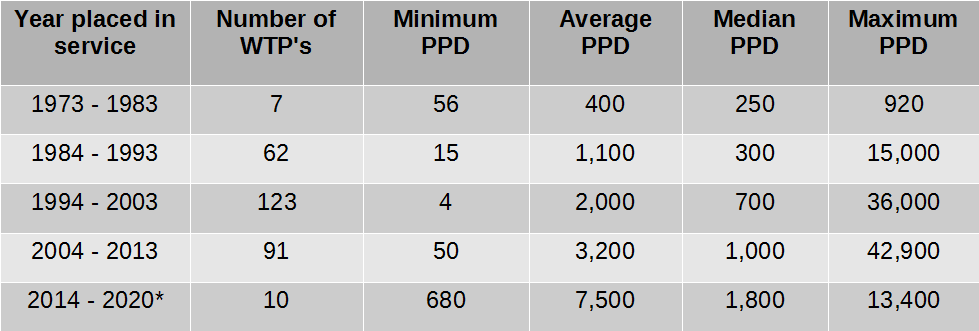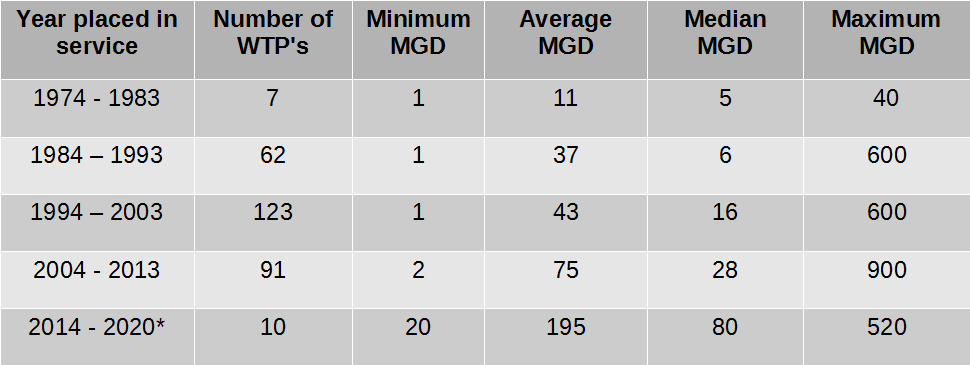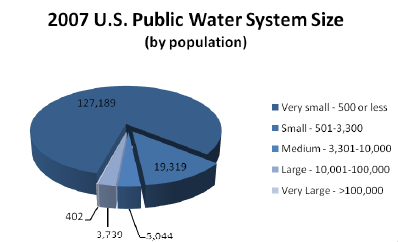Municipal Water Treatment
Ozone Use for Municipal Drinking Water Treatment:
Ozone has been used for municipal drinking water continuously in the USA since 1940. Ozone use for drinking water treatment is one of the oldest and most well known uses for ozone worldwide.
As of 2013, at least 277 Water Treatment Plant's (WTP's) operating in the USA utilize ozone. This number only includes plants larger than 1 MGD capacity. These plants have a combined combined capacity of 14.5 billion gallons per day with ozone production greater than 600,000 lb/day. Since 1993 at least 55 of these plants have been upgraded, again using ozone technology. Proving that ozone was cost effective and a good solution for the application.
Most ozone use for municipal water is in large water treatment plants. Of the 277 WTP's of record less than 30 are plants with a capacity of less than 2 MGD. The median WTP implementing ozone is expected to grow from 5 MGD capacity at the end of 1984 to 80 MGP at the end of 2020.
Future of Ozone Use in Municipal Drinking Water:
The future of ozone in WTP's in the USA is great. The EPA estimates there are over 150,000 municipal WTP's in the USA. Only ~300 of these WTP's are using, or planning on using ozone. Most of these plants are large, or very large. Opportunity for ozone use in WTP's in the USA is untapped.
Small to Medium sized WTP's growth potential in the USA is the greatest. The largest WTP's are targeted for ozone implementation. Also, the majority of ozone implementation is in large WTP's. There are many small to medium WTP's in the USA that could also benefit from ozone use, but are not targeted by the traditional ozone industry. This is the benefit of working with Oxidation Technologies. Our history of industrial and agricultural system integration lends us a great deal of experience integrating medium and large ozone systems that are well suited for medium sized municipalities.

Image shows that WTP's started in 10 year spans shown by water treatment capacity
-It is clear that the average size of WTP using ozone has grown over time
-Emphasis on small and medium WTP's has diminished

Image shows that WTP's started in 10 year spans shown by ozone production.
-The average size ozone system has grown over time
-Emphasis on small and medium WTP's has diminished
Where and Why is Ozone Implemented:
Ozone is used in 42 of the 50 states in the USA. Ozone is used all over the USA for a variety of applications. Ozone use does follow the population trends. The states of California, and Texas are the two largest users of ozone for municipal WTP's.
Ozone is used to replace traditional oxidations:
-Disinfection (Giardia & viruses)
-Taste and odor control
-Reduction of chlorinated DBP's
-Removal of color
-Sulfide oxidation, TOC reduction, Iron and Manganese oxidation
-Enhance coagulation processes

Image shows WTP's using ozone and the purpose for ozone implementation
-Ozone use for municipal WTP's is diverse, and continues to be diverse
-Only the use of ozone for Disinfection has grown consistently in each decade
-Ozone use for “Other” has also grown over time, however this is a large group of uses for ozone in one category.
Summary - Ozone use for drinking water is diverse. Many WTP's throughout the USA will benifit from ozone in some way.
Will Your City or Project Benefit from Ozone Use:
This is tough to answer. The best answer we can give, is call our application engineers for more information.
If pre-oxidation is required for water treatment, then yes, ozone would be a great alternative to those chemicals. If disinfection by products are a concern, then yes ozone would be a great alternative to chemicals producing those DBP's. However, most applications are not this simple, give us a call, we would be glad to help.
Future of Ozone Use:
The future of ozone in water treatment is micro-pollutant, and endocrine disrupting chemicals (EDC's). Micropollutants are substances that are found in relatively low concentrations that are difficult, or impossible to remove with conventional treatment technologies.
Build-up of EDC's in wastewater that is discharged into lakes, or rivers where water is used for drinking water plants is an upcoming concern for water quality.
Ozone has been tested and proven effective in removing many EDC's in wastwater treatment systems. The following is a short list of EDC's ozone has been proven effective for:
-Testosterone
-Androstenedione
-Progesterone
-Estradiol
-Estriol
-Estrone
-Ethynylestradiol
-Carbamazepine
-Bezafibrate
-Diclofenac
-Ibuprofen
-Sulfamethoxazole
For a complete list, details on each EDC, or information about how ozone could be implemented as a pilot test, or full scale system contact our application engineers today.











